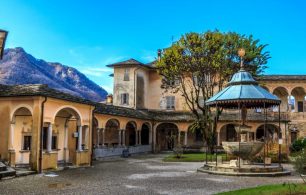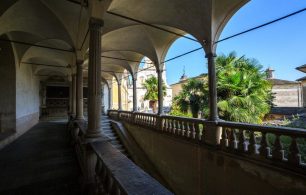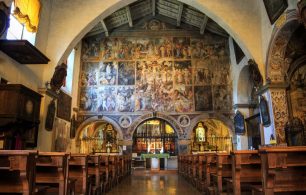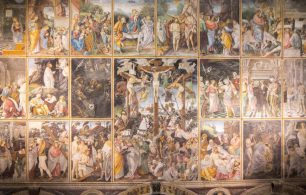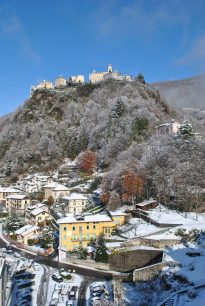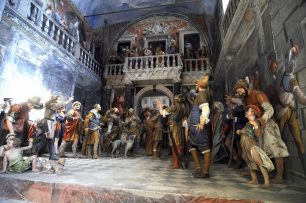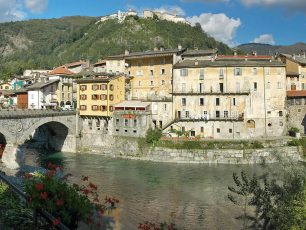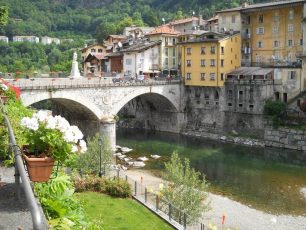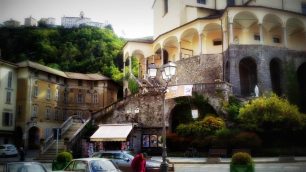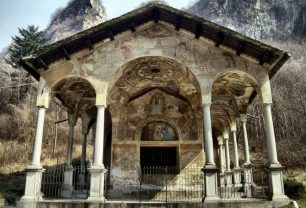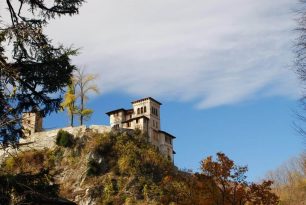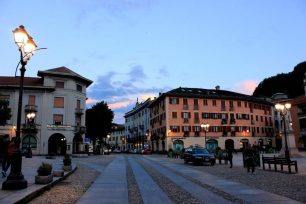The Piedmontese town of Varallo, is historically considered as the “capital” of Valsesia, with regards to its vast artistic and historical heritage. It is a charmingly beautiful town.
In its historic center there are many architectural testimonies: the ancient nucleus of the "contrade", small streets formerly used for trade and craftsmanship, the sixteenth-century building where the Scarognini-D'Adda family from Varese used to live and the spectacular nineteenth-century villas, located in what used to be the residential center of the city and where today all visitors can relive the spirit of the Belle Epoque era.
Characteristic features of Varallo are the many churches and religious buildings among which the Collegiate Church of San Gaudenzio stands out, with the polyptych by Gaudenzio Ferrari, the Churches of Santa Maria delle Grazie (Church of Our Lady of the Graces) and San Marco and the Oratory of the Madonna of Loreto: places where faith, art and history unite to form a fundamental work of art in the panorama of Italian art history.
This is a national monument, and it is located at the foot of the slope that leads from Piazza Gaudenzio Ferrari to the Sacro Monte. Adjacent is the convent which was originally occupied by the Friars Minor of the Observance and has been the religious headquarters of the Order of the Missionary Sisters of Jesus the Eternal Priest since 1953.
The foundation of the convent of Santa Maria delle Grazie (Church of Our Lady of the Graces) is closely linked to that of Sacro Monte; and the church, convent and Sacro Monte are part of a single concept and a single historical and artistic moment which initiated at the end of the fifteenth century.
Upon entering the church, the visitor's gaze is immediately captured by the immense narrative story scenes depicting the Life of Jesus Christ that make up the famous Gaudenzian Wall, completed between 1512 and 1513. It is a prelude and synthesis of what was happening at the Sacro Monte: it is here that the art and poetry of Gaudenzio Ferrari reached that stylistic characteristic which would constitute his distinctive trait and never abandon him in the course of his artistic future.
This complex is the oldest and most important of all the Sacred Mountains (Sacri Monti) in Piedmont and Lombardy and since 2003 it has been part of the UNESCO World Heritage Sites. It is a Monumental Devotional Complex, which is of great importance, not only from a religious point of view, but also from a historical and artistic point of view.
It consists of 45 chapels, or more aptly, real architectural structures, with more than 800 statues, accompanied by paintings of exceptional artistic value. The complex spreads out on the rock terrace overlooking the city and is included in the Special Nature Reserve of the Sacro Monte di Varallo, established in 1980 in order to manage and protect the monument from a naturalistic-environmental point of view.
The creator and first promoter of the construction of the Sacro Monte was Blessed Friar Bernardino Caimi, Franciscan of the Ancient Observance, former Guardian of the Sacred Places of the East, who at the end of the fifteenth century wanted to recreate the "New Jerusalem" on the summit of the dominant mountain Varallo, to allow the faithful who could not go to Palestine to experience the spirituality of the pilgrimage to the Holy Land, faithfully recreating its most symbolic places.
The Sacro Monte has the shape of a real fortified citadel, surrounded by walls and made up of streets, squares, buildings and gardens. Statues and paintings, give shape and voice to the path that narrates the events of the life of Jesus Christ from His Annunciation to the Resurrection.
Among the many artists who worked on the Sacro Monte Varallese over the centuries mention must be made of Gaudenzio Ferrari, one of the greatest Renaissance exponents of the Lombard Piedmontese culture, Giulio Cesare Luini, Giovanni D’Enrico, Tanzio da Varallo and Morazzone.
With Gaudenzio Ferrari, in particular, the initial project of the Sacro Monte to reproduce the Holy Places was, if not completely forgotten, set aside to develop the illustration of the prominent facts of the life of Christ. It was St. Charles Borromeo who the spread knowledge and veneration for the New Jerusalem of Varese and, in the years to come and, many pilgrims followed his example to go the Sacro Monte and this habit, continues to this day.
Antonio d'Enrico, known as Tanzio da Varallo, also worked on the Sacro Monte. Antonio was born in Riale di Alagna around 1578 and died in Borgosesia around 1632-33. He was an artist who studied in Rome and was also influenced to a certain degree by the artwork of Caravaggio and the Caravaggeschi. Masterpieces of Tanzio da Varallo that still remain, are the frescoes in various chapels of the Sacro Monte, where he collaborated with his elder brother Giovanni, creator of extraordinary life-size polychrome statues.
